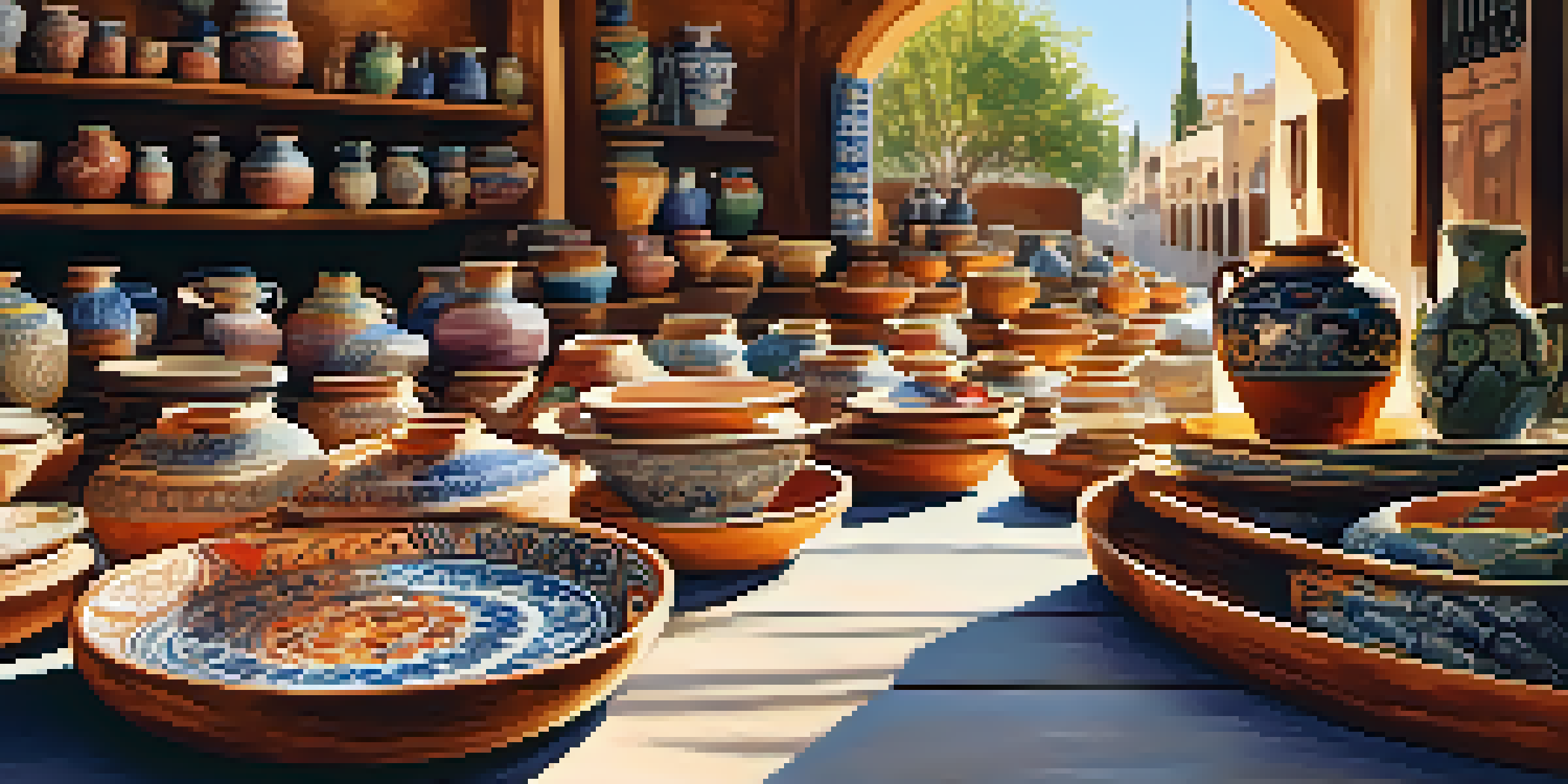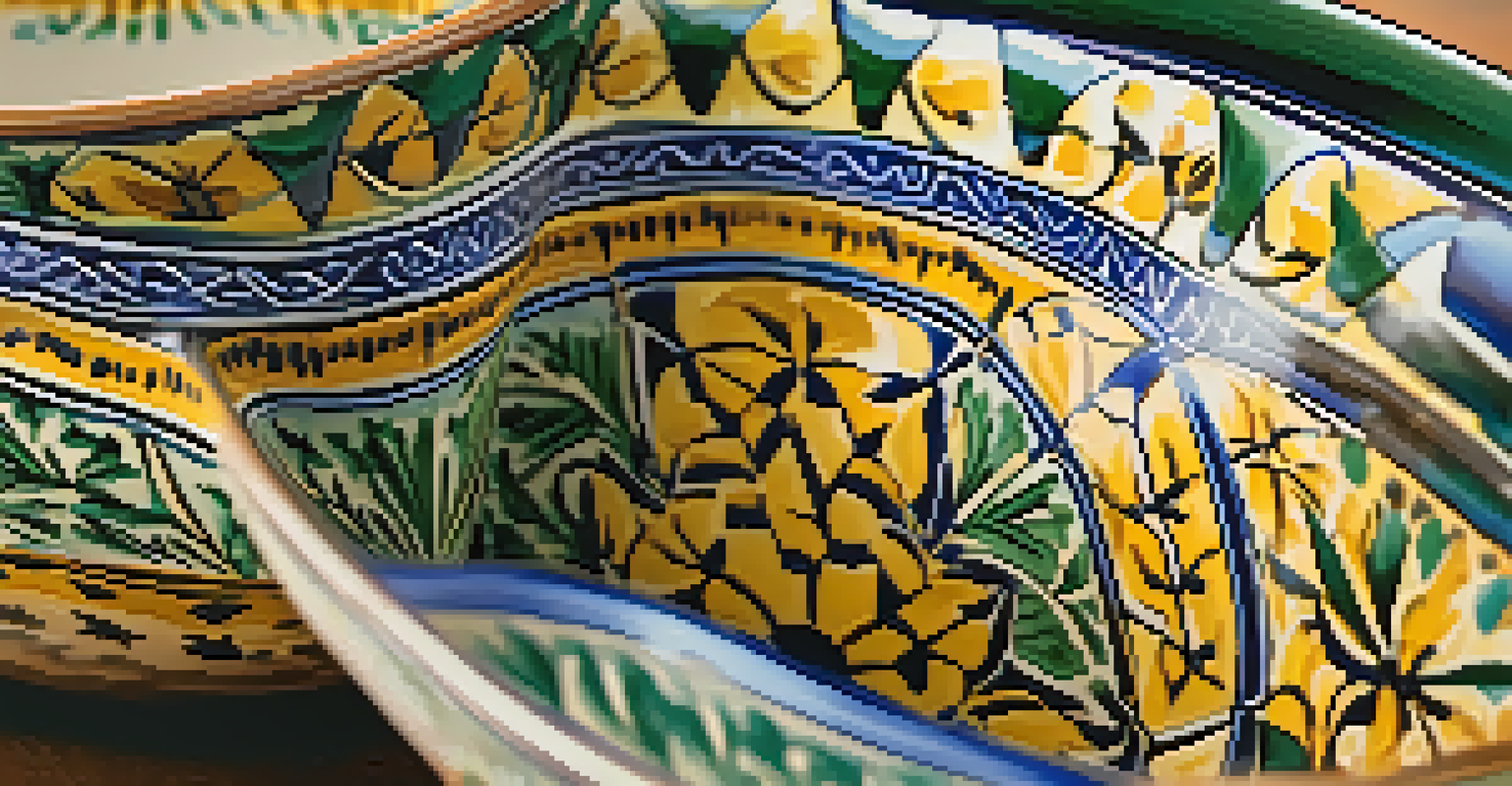Exploring Andalusia: The Art of Traditional Pottery Making

A Brief History of Pottery in Andalusia
Andalusia's pottery tradition dates back thousands of years, influenced by various cultures, including the Romans and Moors. This rich history has left an indelible mark on the region's ceramic styles, making it a fascinating tapestry of artistic expression. Each piece of pottery tells a story, reflecting the diverse heritage and craftsmanship that Andalusia is known for.
Pottery is the art of turning clay into a story, where every piece reflects the culture and creativity of its maker.
From the intricate designs of Talavera to the rustic charm of Albayzín pottery, the evolution of these styles showcases the region's adaptability and creativity. The blending of cultural influences is evident in the use of vibrant colors and unique patterns that adorn each piece. This historical context not only enriches the pottery but also deepens our appreciation for the artistry involved.
Today, many artisans continue to honor these traditions while incorporating modern techniques, ensuring that the art of pottery making remains vibrant and relevant. As visitors explore Andalusia, they can witness this captivating blend of old and new, making pottery a vital part of the region's identity.
The Craftsmanship Behind Andalusian Pottery
Creating traditional Andalusian pottery is a meticulous process that requires skill and patience. Artisans begin by selecting high-quality clay, which is then shaped using techniques passed down through generations. Each potter has their own unique style, often reflecting personal experiences and the stories of their community.

After shaping, the pottery is dried and fired in a kiln, a crucial step that solidifies its structure. The firing process can vary in temperature and duration, influencing the final look and durability of the piece. Once fired, artisans apply colorful glazes, often inspired by the natural beauty of the Andalusian landscape, adding that signature vibrancy we associate with this region.
Rich History of Andalusian Pottery
Andalusia's pottery reflects a diverse heritage, influenced by various cultures over thousands of years.
The final product is not just a functional item but a piece of art that embodies the spirit of Andalusia. Whether it’s a beautifully decorated plate or a striking vase, each piece stands as a testament to the potter's dedication to their craft and the cultural heritage they represent.
Cultural Significance of Pottery in Andalusia
Pottery in Andalusia serves as more than just a craft; it holds deep cultural significance within the community. Traditionally, pottery was essential for daily life, used for cooking, storage, and decoration. Today, these handcrafted items continue to play a role in local customs and celebrations, symbolizing the region's rich traditions.
Art is not a thing; it is a way. Pottery is the embodiment of this idea, connecting us to our heritage and the environment.
Festivals often feature pottery displays, allowing artisans to showcase their work while connecting with locals and tourists alike. These events foster a sense of pride in cultural heritage and encourage younger generations to appreciate and participate in this ancient art form. The community's appreciation for pottery is evident in the way they celebrate its history and craftsmanship.
Moreover, pottery serves as a medium for storytelling, with each design reflecting local myths, historical events, or nature-inspired motifs. This narrative aspect enriches the experience for those who own or purchase these items, making them not just decorative pieces but also connected to the vibrant culture of Andalusia.
Visiting Pottery Workshops in Andalusia
A trip to Andalusia wouldn't be complete without visiting some of its renowned pottery workshops. Many artisans welcome visitors, offering a glimpse into their creative processes and the chance to learn about the history of their craft. These workshops often provide hands-on experiences, allowing participants to try their hand at shaping clay under the guidance of skilled potters.
In cities like Granada and Seville, you'll find workshops that specialize in various styles, from the classic Talavera ceramics to the more contemporary designs. This diversity offers a rich educational experience, as each workshop has its own story and technique. Engaging with local artisans can be an eye-opening experience, revealing the dedication and passion behind each creation.
Craftsmanship and Cultural Significance
Artisans create pottery that embodies local traditions, serving both functional and artistic purposes within the community.
Additionally, purchasing pottery directly from these workshops supports local artisans and helps preserve the tradition for future generations. Visitors leave not only with unique souvenirs but also with a deeper understanding of the cultural significance embedded in each piece.
The Role of Modern Technology in Pottery
While traditional techniques are celebrated, modern technology has also begun to play a role in pottery making in Andalusia. Many artisans have started to incorporate tools and equipment that enhance their efficiency and creativity. For instance, computerized design software allows potters to experiment with patterns and shapes before they even touch the clay.
3D printing has also made its way into the pottery scene, enabling artists to push the boundaries of traditional forms and create intricate designs that would be challenging to achieve by hand. This fusion of technology and tradition encourages innovation while still honoring the age-old practices that define Andalusian pottery.
However, the use of technology doesn't diminish the artistry; instead, it complements it. The challenge for many potters lies in balancing these modern advancements with the traditional aspects of their craft to maintain the authenticity and cultural significance of their work.
Pottery as a Sustainable Art Form
Sustainability is a growing concern in many industries, and pottery is no exception. In Andalusia, many artisans are taking steps to ensure that their practices are environmentally friendly. This includes sourcing local clay and using natural glazes, which not only reduces their carbon footprint but also supports the local economy.
Additionally, some potters are embracing recycled materials, incorporating glass or ceramic scraps into their designs. This innovative approach not only minimizes waste but also adds a unique character to their pieces. By focusing on sustainability, these artisans are not only preserving their craft but also setting an example for future generations.
Embracing Modern Techniques
Modern technology enhances traditional pottery methods, allowing artisans to innovate while preserving cultural authenticity.
As consumers become more environmentally conscious, supporting sustainable pottery practices is essential. Purchasing pieces made with eco-friendly methods contributes to a more sustainable future while celebrating the artistry of Andalusian pottery.
Exploring Pottery Markets in Andalusia
No exploration of Andalusian pottery is complete without a visit to local markets. These vibrant spaces are filled with a plethora of handcrafted items, showcasing the skill and creativity of local artisans. Markets like the Mercado de Triana in Seville offer a stunning array of pottery, from functional kitchenware to striking decorative pieces.
Walking through these markets, visitors can engage with potters, ask about their techniques, and hear the stories behind their creations. This direct interaction adds a personal touch to the shopping experience, making each purchase feel special. You might even find a one-of-a-kind piece that resonates with you, connecting you to the culture of Andalusia.

Additionally, these markets often host workshops and demonstrations, allowing visitors to see pottery being made in real-time. This immersive experience not only enriches your understanding of the craft but also highlights the importance of supporting local artisans in preserving this beautiful art form.